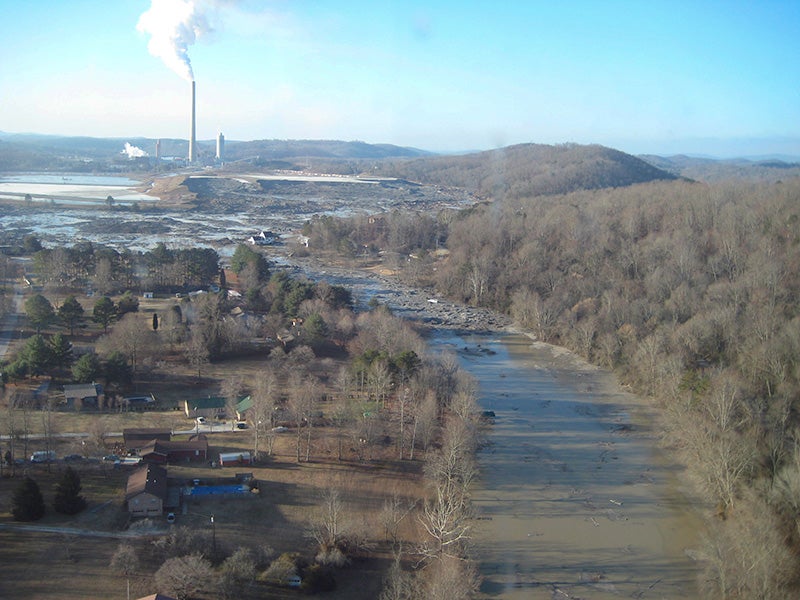Industry's Coal Ash Claims are Bogus
Polluter arguments against coal ash regulations are disproved by their own data

This page was published 11 years ago. Find the latest on Earthjustice’s work.
Editor’s note: This blog post was co-written with Scott Slesinger, legislative director at NRDC
It’s been several years now since the Environmental Protection Agency proposed managing coal combustion residuals (CCR, aka coal ash) under the Resource Conservation and Recovery Act (RCRA). While coal ash waste itself can be quite dangerous when it is disposed, there are many safe uses of it when it is properly recycled. In fact, earlier this year the EPA declared the use of encapsulated fly ash and flue gas desulfurization (FGD) sludge in concrete and wallboard to be safe
Over these years one of most common arguments of the Edison Electric Institute, utility industry and the American Coal Ash Association (ACAA) has been that declaring coal ash a “special waste” under RCRA would create a “stigma” against recycling the product. In fact, they argue the mere discussion of managing coal ash as a hazardous waste has already harmed the coal ash recycling industry. But let’s look at the facts: Using data provided for free online by the American Coal Ash Association, we made a direct comparison between two equivalent products: fly ash used in concrete, one of the major coal ash recycling practices, and Portland and masonry cement production (fly ash can be a substitute or supplement for Portland cement in concrete, and masonry cement is just a different formulation that still uses Portland cement; this cement data comes from the US Geological Survey). If the stigma really was having an impact on the market, non-fly ash substitutes should be rising while fly ash should be plummeting. While USGS has numbers up to 2013, ACAA’s latest numbers only go to 2012. Here’s the resulting chart: Clearly, Portland and masonry cement were hit pretty hard too. Since the ACAA claims that coal ash has been stigmatized ever since 2008, We went a step further and compare how each has done compared to 2008. For an extra layer of comparison, we threw in overall construction spending (from the US Census Bureau, adjusted for inflation): Again, it looks like the real take away from the data is that it’s been a rough recovery for the construction industry as a whole. Construction spending and demand have suffered, and with it so has production of common construction materials. Despite their own data, the American Coal Ash Association looks to their “Production and Use Survey” and blames the proposed rule rather than the economy for the downturn: “The beneficial use of coal ash has been harmed by regulatory uncertainty surrounding the rulemaking EPA commenced in the wake of a December 2008 failure of a coal ash disposal facility in Tennessee.” Perhaps if it weren’t so cheap under present standards to simply dump coal ash waste in unlined pits more companies would feel inclined to safely and productively recycle coal ash? Utilities seem to be quite happy with the status quo standards under which we’ve seen the Kingston TVA and North Carolina Dan River spills. On the other hand, requiring a proper level of care in the disposal of coal ash should raise the price of disposal, which in turn would make safe and productive recycling an even better deal. If properly regulated would coal ash stigma really kick in? History says no. EPA asked for cases where regulating a waste stream caused a decrease in the recycling alternative to disposal. Of the many waste streams regulated since 1980, they can’t identify one.[1] Despite the history, the President’s Office of Management and Budget (OMB) insisted that the cost-benefit analysis of the rule assume the stigma against coal ash would last for 50 years. That unjustified analysis needs to be ignored and the people living near these sites be protected. Stigma is a bogus issue. The industry’s own data show there is no stigma, and there is no reason why lives shouldn’t be protected and a strong final rule approved by this Administration this fall. Special thanks to Sean Alcorn of NRDC for the charts prepared from the ACAA data. [1] The full Regulatory Impact Analysis (as edited by OMB) is available at http://www.regulations.gov/#!documentDetail;D=EPA-HQ-RCRA-2009-0640-0003. The discussion of prior experience in stigma starts on p.157.
Established in 2008, Earthjustice’s Northeast Office, located in New York City, is at the forefront of issues at the intersection of energy, environmental health, and social justice.